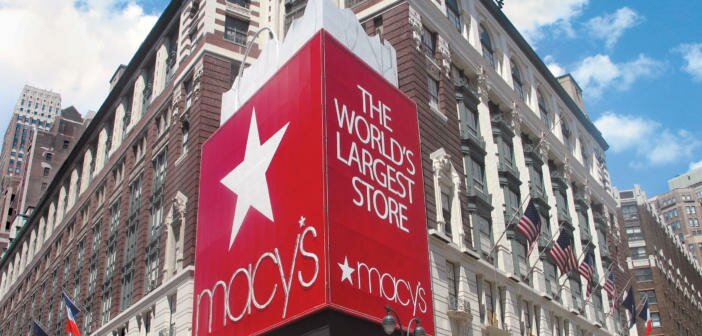With Macy’s sales and earnings continuing to decline over the last few quarters, the department store retailer said it would close 100 stores and boost e-commerce and other omnichannel and strategic initiatives to reinforce its performance.
Macy’s stated that it would close approximately 100 full-line Macy’s locations, most of which it will shutter in early 2017. The company said the locations of the 100 stores to be closed will be announced at a later date.
For the second quarter, Macy’s posted company net earnings of $11 million, or three cents per diluted share, versus $217 million, or 64 cents per diluted share, in the year-prior period.
With the exclusion of asset impairment and other charges primarily related to upcoming store closings and non-cash retirement plan settlement charges, second quarter earnings per share came in at 54 cents, Macy’s maintained. An analyst average estimate published by MarketBeat called for diluted earnings per share of 44 cents.
Comparable sales on an owned plus licensed basis declined 2% in the quarter versus the year-previous period, Macy’s reported. On an owned basis, second quarter comps slid 2.6%.
Net sales were $5.87 billion versus $6.1 billion in the year-earlier period. The closing of 41 stores was a factor in sales declines, Macy’s asserted. Operating income was $117 million as compared with $436 million in last year’s second quarter.
“We are encouraged by the distinct improvement in our sales and earnings trend in the second quarter,” said Terry Lundgren, Macy’s chairman and CEO. “Over the past few months, we have been saying that a setback is a setup for a comeback, and we now believe we are set up well to proceed to a comeback. Our sales strengthened month-by-month throughout the second quarter. This trend improvement gives us confidence in our plans for the back half of the year, and in our strategic planning for improvements to our business model going forward.”
Lundgren said that, in the quarter, certain factors worked to prop Macy’s sales including “a normalized weather pattern, which contributed to a sales lift in our apparel business. We also saw a smaller decrease in tourist spending during prime summer travel months, supported by strengthened promotional events designed to increase customer traffic and conversion. Macy’s first-ever ‘Black Friday in July’ event was a terrific success which drove record store and online sales for a mid-year period. We also are pleased that a number of sales-driving initiatives put in place in recent months are beginning to gain traction. These include additional investments in store staffing and visual presentation.”
During the second quarter, Macy’s reported that it opened seven Bluemercury freestanding specialty stores. It also opened eight Backstage and seven Bluemercury shops inside Macy’s department stores, with another five in-store Backstage and seven in-store Bluemercury shops planned for the fall season. In the fall season, scheduled store openings include a Macy’s in Kapolei, HI, a Backstage freestanding store in San Antonio, a Bloomingdale’s Outlet in Orange, CA, and 10 additional Bluemercury freestanding specialty stores.
In announcing the 100 store closings, Macy’s maintained that it intended to bolster the company brand with exclusive products and an improved shopping experience. Macy’s also plans to recreate the physical store presence as customer shopping preferences and patterns evolve, reallocating investments to highest-growth-potential stores and digital businesses, and capitalizing on opportunities within the company’s real estate portfolio.
“We operate in a fast-changing world, and our company is moving forward decisively to build further on Macy’s heritage as a preferred shopping destination for fashion, quality, value and convenience. This involves doing things differently and making tough decisions as we position ourselves to serve customers who have high expectations of their favorite stores, online sites and apps,” Lundgren said.
Macy’s operates about 880 stores in 45 states under its range of retail banners.




